The Complete Guide to Locker Security Systems for Workplaces, Gyms, and Schools (2025 Edition)
November 27, 2025
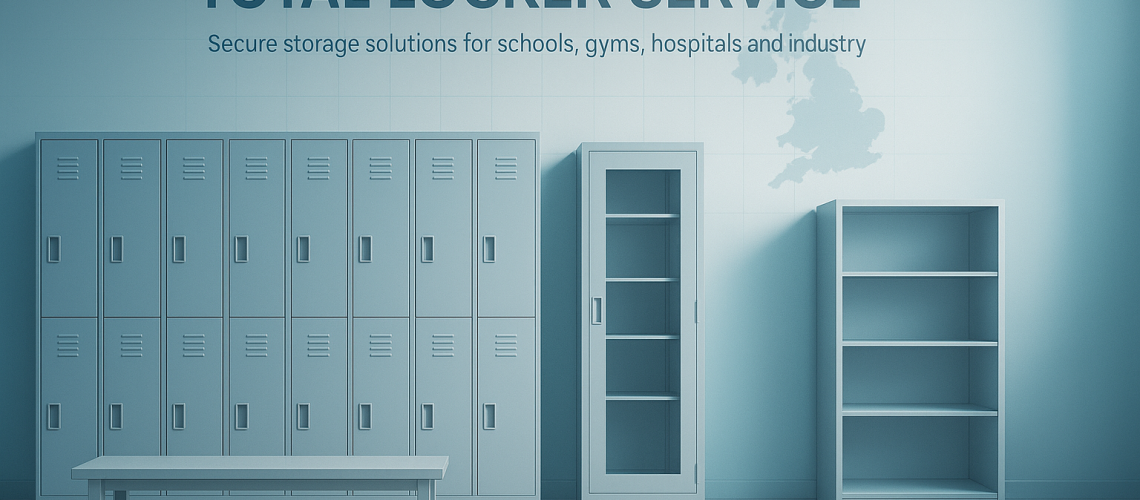
Locker security systems. Locker security has evolved dramatically in the last decade. What was once a simple combination lock or a metal key has become a sophisticated ecosystem of digital systems, RFID-based access control, app-managed lockers, biometric verification, and cloud-connected management platforms. As workplaces modernise, gyms expand their digital offerings, schools focus more on safeguarding, and leisure centres adapt to changing visitor expectations, the demand for reliable and secure locker systems has never been higher. Yet many organisations still rely on outdated, unsuitable, or poorly maintained locking solutions. These systems expose them to theft, operational disruption, compliance issues, and unnecessary costs.
This comprehensive guide provides a full overview of modern locker security systems in the UK. It covers mechanical options, digital keypad locks, RFID solutions, coin-return and coin-retain systems, hybrid models, and the future of smart and biometric lockers. You will also find clear comparisons, practical examples, maintenance guidance, and a step-by-step process for upgrading an existing locker system. Whether you operate a workplace, gym, school, hospital, university, warehouse, or leisure facility, this 2025 edition gives you the clarity you need to choose the right system and protect your staff, visitors, and assets.
1. Why Locker Security Matters More Than Ever
Locker security affects nearly every type of organisation, even those that don’t immediately think of themselves as “locker-heavy environments.” Workplaces with hybrid staff schedules need secure storage for personal items. Gyms must manage high volumes of visitors with varying access levels. Schools need robust systems that withstand heavy use and prevent safeguarding breaches. Hospitals store both personal items and controlled uniforms. Retail units rely on staff lockers to prevent losses and keep personal items safe during shifts.
Thefts are increasing across UK facilities, driven by greater footfall, higher staff mobility, and the value of personal devices carried by visitors and employees. Locker security has become not only a physical deterrent against theft, but a critical part of operational stability and user trust. In the context of insurance, GDPR, and organisational liability, locker systems now play a direct role in ensuring compliance and accountability.
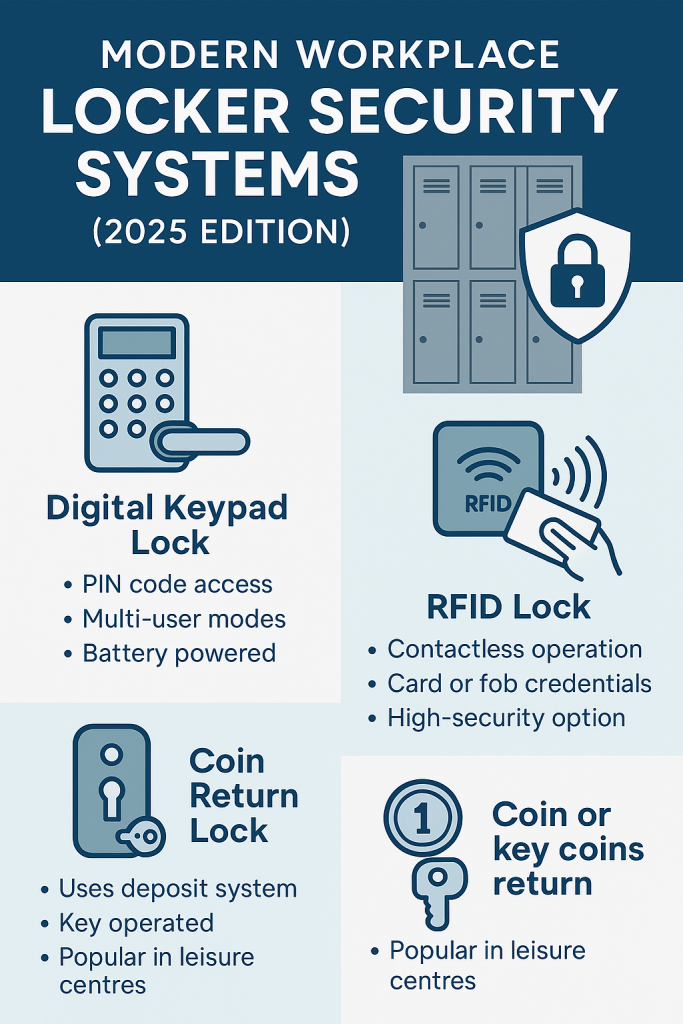
The rise of digital transformation across the UK has reshaped expectations. Staff and customers now expect contactless access, app-based management, and lockers that integrate with existing systems such as staff ID cards. Facility managers are under pressure to reduce key losses, lower maintenance costs, and improve turnaround speed when users need access resets. This guide breaks down exactly how to achieve those goals.
2. Locker security systems. Overview of Modern Locker Security Systems
Locker security systems can be grouped into six major categories. Each has its strengths and limitations depending on the environment. Choosing the right one depends on usage patterns, budget, facility type, maintenance capability, security levels, and whether you require audit trails or integration with wider access control systems.
- Mechanical cam locks – Traditional, key-operated, affordable, but high risk of key loss.
- Mechanical combination locks – Keyless but limited security and prone to wear.
- Digital keypad locks – Battery-powered, programmable, ideal for staff and gym usage.
- RFID locker locks – Contactless access via wristbands, cards, or fobs; fast and reliable.
- Coin return/coin retain locks – Still common in leisure centres and pools.
- Smart, app-based, or biometric lockers – The future of secure storage for high-usage environments.
A well-designed system reduces administrative overhead, prevents theft, speeds up locker allocation, and increases user satisfaction. Poorly chosen systems create bottlenecks, raise maintenance costs, and often lead to significant downtime for locker banks. Selecting the correct system requires understanding how each type functions in real-world conditions. The remainder of this guide explains each system in detail.
3. Locker security systems. Mechanical Locker Locks
Mechanical locker locks remain the most widely used type in UK schools, factories, staff rooms, and legacy locker banks. They are robust and familiar, and many organisations continue to choose them because they are affordable and require no batteries or electronics.
Pros of Mechanical Locks
- Low upfront cost
- No batteries or electronics to manage
- Resistant to moisture and suitable for wet areas
- Simple for users to understand
- Compatible with most locker materials
Cons of Mechanical Locks
- High rate of lost or broken keys
- Expensive key replacement cycles
- No access tracking or audit trails
- Master keys must be controlled tightly
- Locks wear out faster in high-usage areas
Mechanical cam locks are also easy to bypass if damaged, making them less suitable for modern gyms or workplaces where security expectations are higher and theft incidents carry greater consequences. While still common in schools, many institutions are transitioning to keyless or digital systems to reduce lost-key administration.
4. Locker security systems. Digital Keypad Locker Locks
Digital keypad locks are one of the most popular upgrades for organisations moving away from mechanical key systems. These battery-powered locks allow users to enter a unique code for each use or for long-term assignments. They reduce the need for physical keys and offer improved security for high-usage sites.
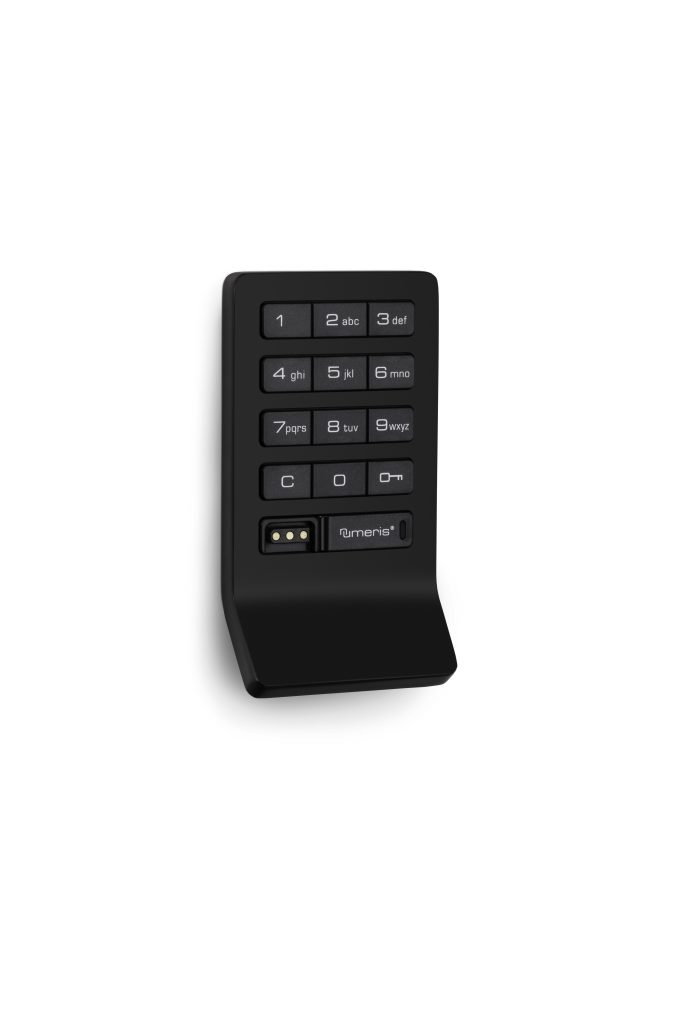
Advantages of Digital Keypad Locks
- No keys to lose
- Simple to manage and reset
- Supports one-time user codes for gyms and spas
- Long battery life (often 2–5 years)
- Emergency master override systems
- Suitable for both dry and mildly humid environments
Digital keypad locks reduce administrative overhead, particularly in staff-heavy environments such as warehouses, retail stores, and manufacturing sites. They are also widely used in schools, where code-based systems minimise the constant issue of lost keys.
Disadvantages
- Batteries must be monitored and replaced on schedule
- Users may forget codes if not using the locker regularly
- Unsuitable for extremely wet environments such as swimming pools
Despite these limitations, digital keypad systems strike an excellent balance between accessibility, cost, and user convenience. For many workplaces, they are the ideal middle-ground investment before moving into more advanced RFID or app-based systems.
5. RFID Locker Systems (The Fastest-Growing Solution)
RFID locker locks represent one of the most significant developments in locker security. These locks are activated using contactless cards, fobs, or silicone wristbands. RFID systems are extremely reliable, quick to operate, and well-suited for gyms, leisure centres, workplaces, universities, and large facilities where users frequently access lockers throughout the day.
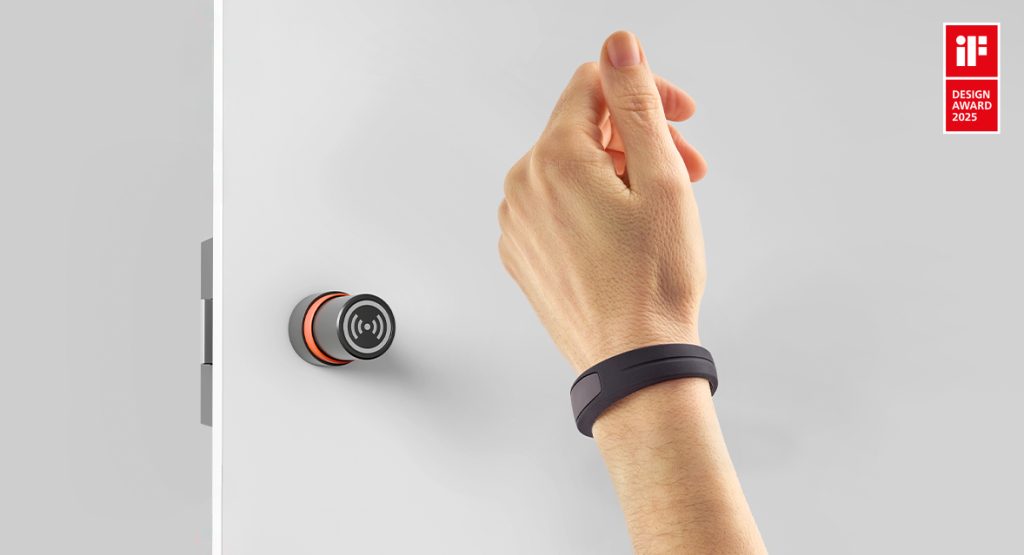
Benefits of RFID Locker Systems
- Fast tap-and-go access
- Integrates with staff ID cards and membership systems
- No codes to remember and no keys to lose
- Highly durable
- Supports multi-user modes (ideal for gyms)
- Allows easy reprogramming
RFID systems dramatically reduce theft in commercial gyms because lockers automatically relock when users close the doors. They are also preferred in corporate environments where lockers need to integrate with existing access cards used for entry gates and office doors.
Limitations of RFID Systems
- Initial investment is higher than mechanical systems
- Requires compatible RFID cards or wristbands
- Wet environments require water-resistant lock housings
However, long-term cost analysis shows RFID systems are often cheaper to operate due to reduced servicing, fewer lost credentials, and improved user flow. Many gyms and universities are fully transitioning to RFID by 2026.
6. Coin Return and Coin Retain Locker Locks
Despite the rise of digital systems, coin locker locks remain widely used in leisure centres, swimming pools, and public facilities. These systems are familiar to visitors and offer an easy way to manage locker turnover without assigning individual credentials.
Coin Return vs Coin Retain
- Coin Return: Users insert a coin and retrieve it after use. Good for high turnover.
- Coin Retain: The facility keeps the coin. Encourages revenue generation.
Coin systems are especially effective in wet changing areas where electronic locks may be unsuitable. However, they require regular maintenance to ensure coin mechanisms function reliably.
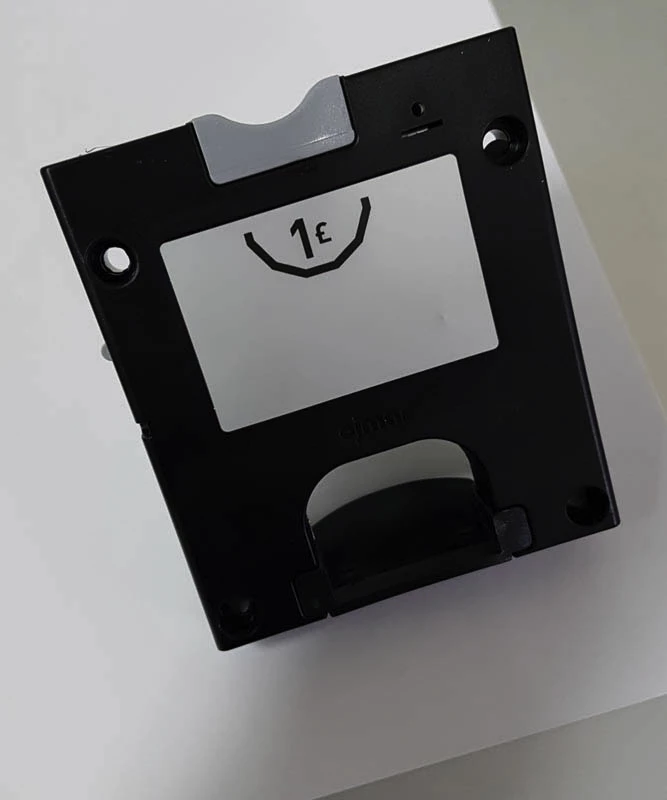
7. Hybrid Locker Systems
Hybrid locker systems combine multiple access technologies—such as RFID + PIN code, or RFID + mechanical override. They are used in environments that require both user convenience and administrative redundancy. For example, a gym may use RFID wristbands while staff retain a digital master code for emergency access.
- Ideal for large organisations
- Supports various user types (staff, visitors, contractors)
- Enables audit trails for specific lockers
- Useful where certain lockers require elevated access permissions
Hybrid systems also help organisations transition gradually from mechanical or digital lock fleets to full RFID ecosystems, minimising upfront costs while modernising the user experience.
8. How to Choose the Right Locker System for Your Environment
The ideal locker security system is different for each facility. The following recommendations provide a structured way to match your environment to the most appropriate locking system.
Workplaces and Offices
- RFID or digital keypad locks recommended
- Integration with staff ID cards
- Audit trails for sensitive departments
- Keyless systems reduce admin time
Factories and Warehouses
- Robust mechanical or digital systems
- Heavy-duty cam locks for PPE lockers
- Clear master key strategy for supervisors
Gyms and Leisure Centres
- RFID systems are the gold standard
- Waterproof housings for wet areas
- Coin return locks remain popular in pools
- Multi-user modes for fast turnover
Schools
- Digital keypad locks reduce lost keys
- Mechanical locks still common for cost reasons
- RFID increasingly used in sixth-form and university facilities
NHS and Healthcare Sites
- RFID access with hygiene-friendly wristbands
- Keyless systems reduce contamination points
- Audit trails useful for staff uniform lockers
9. Common Causes of Locker Security Failures
Most locker security incidents arise from predictable problems that can be prevented with proper planning and maintenance. Understanding these issues helps facility managers choose systems that resist failure and minimise downtime.
- Users losing keys or forgetting codes
- Worn cams or damaged latch mechanisms
- Incorrect lock choice for the environment
- Poor installation leading to weak security
- Battery failures in digital systems
- RFID desynchronisation issues
- Lack of a master key or emergency access plan
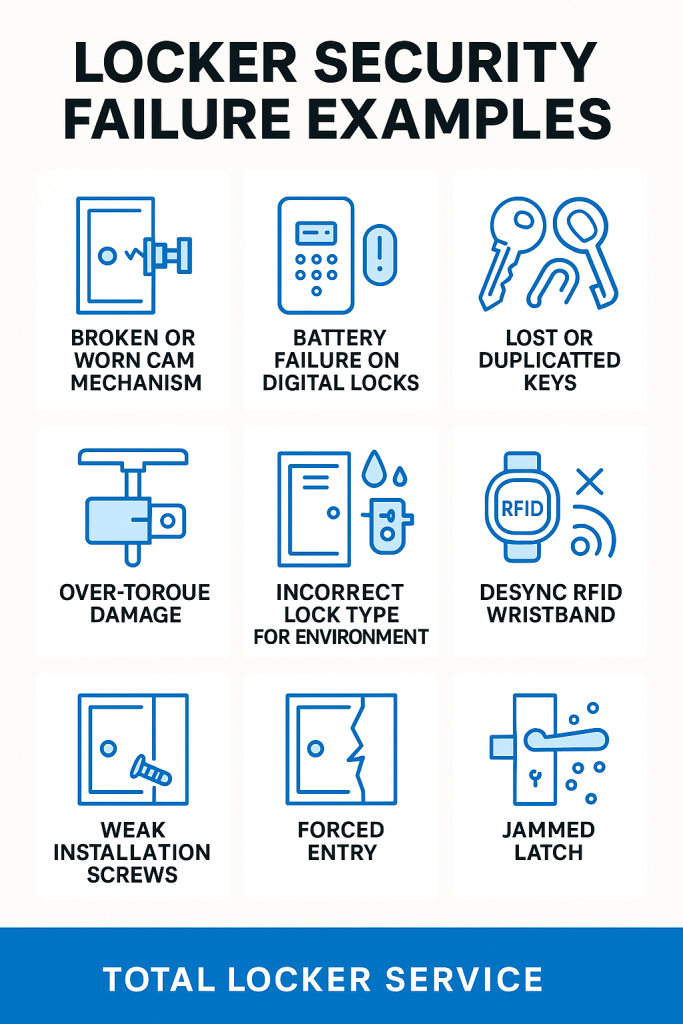
Preventing these issues is significantly easier with modern systems. Digital and RFID locker locks dramatically reduce day-to-day incidents, and well-planned maintenance ensures long-term reliability across entire locker fleets.
10. How to Upgrade an Existing Locker System
Upgrading locker systems does not always require replacing the lockers themselves. In many cases, retrofitting new locks onto existing locker bodies is cost-effective and fast. The following process outlines how to migrate from older mechanical systems to more modern solutions.
- Step 1: Audit your current locks and locker condition.
- Step 2: Identify the total number of keys and duplicates.
- Step 3: Record the lock type and cam mechanism.
- Step 4: Review access requirements for each department.
- Step 5: Decide whether to adopt keypad, RFID, or mixed systems.
- Step 6: Evaluate wristbands, cards, or fob options.
- Step 7: Plan a phased rollout beginning with high-use areas.
Many organisations choose a hybrid upgrade strategy. High-traffic areas (such as gym locker rooms or warehouse PPE lockers) receive RFID or keypad systems, while low-traffic staff lockers retain mechanical locks. This approach balances cost and functionality while moving the organisation towards future-ready security.
11. Full Cost Comparison: Mechanical vs Digital vs RFID
Cost is one of the most important factors when selecting a locker system. Although mechanical systems have the lowest initial cost, the long-term expense of key management, replacements, and wear can make them more costly over time. Digital and RFID systems have higher upfront prices but often result in lower lifetime costs due to reduced maintenance and improved user behaviour.
| Lock Type | Upfront Cost | Maintenance Cost | Security Level | Best For |
|---|---|---|---|---|
| Mechanical Cam Lock | Low | High (key replacement) | Medium | Schools, low-usage workplaces |
| Digital Keypad Lock | Medium | Low (battery changes) | High | Gyms, offices, warehouses |
| RFID Locker Lock | Medium–High | Very Low | Very High | Gyms, universities, corporate sites |
| Coin Return/Retain Locks | Low–Medium | Medium | Medium | Leisure centres, pools |
12. Maintenance and Servicing
Even the most robust locker system requires regular check-ups. Neglecting maintenance leads to sticking locks, broken cams, failed batteries, or inconsistent RFID performance. Regular servicing extends lock lifespan and ensures consistent operation across your locker fleet.
- Check moving parts every 6–12 months
- Test battery levels in digital locks
- Inspect cams and latches for wear
- Clean RFID readers to prevent failure
- Verify master key availability and condition
- Record maintenance in a central log

13. Wet, Dry, and Outdoor Environments
Different environments require different locker lock specifications. Moisture, temperature, and exposure levels all affect lock performance and safety. Choosing the appropriate lock for the environment ensures reliability and prevents accelerated deterioration.
- Dry areas: All lock types suitable (mechanical, digital, RFID).
- Wet areas: Use coin locks or water-resistant RFID models.
- Outdoor areas: Use stainless steel mechanical locks; avoid electronics unless IP-rated.

Environmental suitability is one of the most overlooked factors in locker system selection. Lock failures in wet environments often stem from using digital or mechanical locks not designed for moisture exposure.
14. Frequently Asked Questions
Below are the most common questions asked by facility managers, staff, and contractors when choosing locker systems.
- Which lock type is best for gyms? RFID systems provide the fastest and most secure user experience.
- What is the most secure locker lock? High-grade RFID or hybrid systems with audit trails.
- Can I convert old lockers to digital? Yes, most lockers can be retrofitted with keypad or RFID locks.
- Should I mix lock types? Often yes—different areas have different needs.
- Do digital locks work in wet areas? Only if IP-rated; otherwise use coin or specialised RFID.
15. Conclusion: Future-Proofing Your Locker Security
Locker security systems have never been more important. As users expect contactless access, fast operation, and secure storage, organisations must modernise their locker fleets to keep pace with current standards. Whether you choose mechanical locks, digital keypad systems, RFID technology, or hybrid smart locker solutions, the right system can transform both security and user satisfaction.
Total Locker Service provides industry-leading locker locks, RFID systems, digital locks, key cutting, replacement keys, master keys, and fully stocked lockers for workplaces, gyms, schools, universities, and leisure centres across the UK.
- Locker Locks
- RFID Locker Locks
- Ojmar Locker Locks
- Coin Return Locks
- Digital Keypad Locks
- Key Cutting Service
- Replacement Locker Locks
- Locker Servicing & Repairs
Discover more from Blog Total Locker Service
Subscribe to get the latest posts sent to your email.